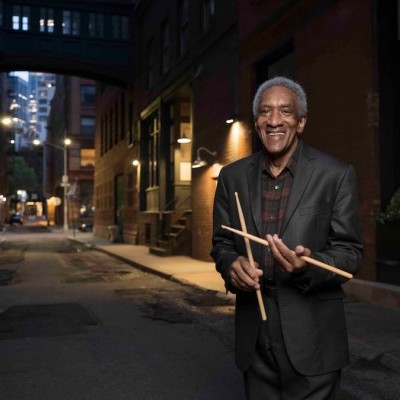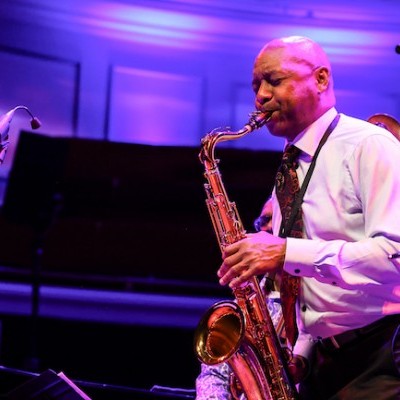Jun 3, 2025 11:25 AM
In Memoriam: Al Foster, 1943–2025
Al Foster, a drummer regarded for his fluency across the bebop, post-bop and funk/fusion lineages of jazz, died May 28…

New York City shaped the motifs that run throughout Basquiat’s work. Shown here are his pieces King Zulu (left) and Dog Bite/Ax to Grind.
(Photo: Jean-Michel Basquiat)Jean-Michel Basquiat’s bold and challenging images have gone from their origins in the streets of New York to worldwide acclaim. Musical ideas were vivid throughout his work as part of the vibrant contrasting colors, declarative words and enigmatic symbols that have become his identifiable style.
An upcoming exhibit, Seeing Loud: Basquiat And Music, emphasizes the artist’s focus on experimental and improvisational sounds, including jazz and its creators.
The works will be on display at the Montreal Museum of Fine Arts from Oct. 16 until Feb. 19. In April 2023, the paintings travel to Cité de la Musique in Paris. Both museums will also host concerts as part of their programs. Saxophonist James Brandon Lewis and an American-Malian guitar collaboration featuring Eric Bibb and Habib Koite are slated performers for the Paris exhibit.
Mary-Dailey Desmarais, chief curator at the Montreal Museum of Fine Arts, intends to show viewers how Basquiat internalized and reworked his sonic influences.
“We want people to leave this exhibition understanding how musical Basquiat’s mind was through the works,” Desmarais said. “This goes far beyond just an image of Charlie Parker, or an image of a musical instrument. It’s deeper than musical iconography. It’s the structure of the painting he was making. There was this kind of cultural nexus in New York in the late 1970s/early 1980s where you saw this collaboration between artists and musicians and saw this fluidity that fed his practice in interesting ways.”
Basquiat’s life and artistic practice echoed several musicians he admired. Born in 1960 to Haitian and Puerto Rican parents in Brooklyn, he rebelled against his middle-class upbringing but highlighted themes from the African diaspora in his paintings. The exhibits will show that one of his first pieces was a flier for saxophonist Arthur Doyle. He also combined what he saw in the late-’70s New York City streets with his studies of classical artists, creating a mashup that drew on graffiti as well as from such canonical painters as Pablo Picasso. Using whatever he could for canvasses, his works frequently presented jazz musicians as heroes. As Basquiat started to become a global celebrity, he died of a heroin overdose at age 27.
Throughout his short career, Basquiat worked across different media and drew on diverse musical references, according to Vincent Bessières, who is curating the Paris exhibit and has worked as a jazz journalist and producer. That came through in how Basquiat painted as much as who he painted.
New York itself shaped the motifs that ran throughout Basquiat’s work. Pianist Matthew Shipp moved to Manhattan’s East Village in 1983 and encountered Basquiat in the neighborhood, especially in such clubs as Area. Shipp said that this was a time and place for absorbing everything from early hip-hop to European synth pop. Jazz was part of that mixture and Shipp believes that Basquiat identified with its creators’ attitudes and spirits. So it was no accident that the hip-hop song that Basquiat produced for Rammellzee was titled “Beat Bop.”
“Basquiat saw the bebop cats as Black artists who created a complete counter code of their own, an outside code,” Shipp said. “They were virtuosic in a way that was undeniable and weren’t genuflecting to European classical music values. That outlaw code that Parker, Dizzy Gillespie, Thelonious Monk and Bud Powell had, I think he really related to that energy field.”
Cultural critic and curator Carlo McCormick also lived nearby at the time and knew Basquiat, who he has extensively written about. He mentioned the artist’s own noise band Gray and said that in the neighborhood, artists, musicians and poets would seek out information where “everyone was an autodidact.” Meanwhile, Sun Ra and Tito Puente would play neighborhood block parties. Taking it all in, McCormick believes that Basquiat approached jazz with an attitude that was similar to many of his neighbors.
“Like everyone else at the time, Jean-Michel’s tastes were a little more eclectic,” McCormick said. “Jazz represented as an intellectual and spiritual center of African American identity and thinking. This was crucial to him as a mode of learning and digesting things.”
With gentrification, Basquiat’s old stomping grounds have become unaffordable to most upstart musicians and artists.
The cost of Manhattan property rising exponentially as the auction prices of his paintings continue accelerating is likely not coincidental. But community still offers a crucial role in his art’s presentation. Desmarais added that Basquiat’s multidisciplinary ideas and cultural background help make her city ideal for the exhibit’s premiere.
“For Montreal, with its incredible musical communities, wonderful jazz festival and strong Haitian population,” she said, “I hope that this exhibition will resonate.” DB

Foster was truly a drummer to the stars, including Miles Davis, Sonny Rollins and Joe Henderson.
Jun 3, 2025 11:25 AM
Al Foster, a drummer regarded for his fluency across the bebop, post-bop and funk/fusion lineages of jazz, died May 28…

“Branford’s playing has steadily improved,” says younger brother Wynton Marsalis. “He’s just gotten more and more serious.”
May 20, 2025 11:58 AM
Branford Marsalis was on the road again. Coffee cup in hand, the saxophonist — sporting a gray hoodie and a look of…

“What did I want more of when I was this age?” Sasha Berliner asks when she’s in her teaching mode.
May 13, 2025 12:39 PM
Part of the jazz vibraphone conversation since her late teens, Sasha Berliner has long come across as a fully formed…

Roscoe Mitchell will receive a Lifetime Achievement award at this year’s Vision Festival.
May 27, 2025 6:21 PM
Arts for Art has announced the full lineup for the 2025 Vision Festival, which will run June 2–7 at Roulette…

Benny Benack III and his quartet took the Midwest Jazz Collective’s route for a test run this spring.
Jun 3, 2025 10:31 AM
The time and labor required to tour is, for many musicians, daunting at best and prohibitive at worst. It’s hardly…